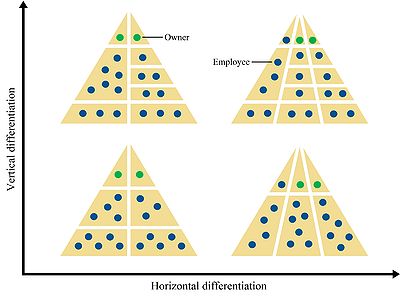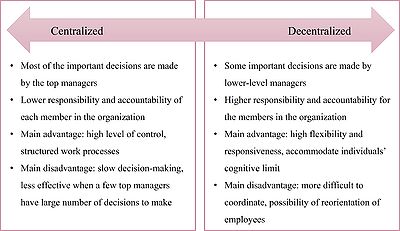Organizational context
The organizational context in project management constitute of the structural link between projects and the organization involved in the project [1]. As projects, programs, and portfolios are naturally performed by a group of individuals, the relationships among the project team members as well as between the team and the work are formed. The congregation of these relationships contributes to the environment of the projects and the project success, creating a specific context for each project. This is where the concept of Organizational Theory and Design is developed to address the organizational context which inherently formed when individuals work together, and ultimately change individuals' behavior and build a desired work environment which suits the characteristics of specific projects.
Contents |
Main Idea
As the business environment becomes more fluid and complex, many kinds of challenges arise for an organization to compete and survive in the market. Organizations overcome these challenges by continuously optimizing their resources, improving their operations, and more. These activities are carried out in different style from short-small specialized projects to large-extensive development programs. Generally, all kinds of work requires efforts of a project team and other resources to generate output. Thus, in project management perspective, the project cannot be finished by itself but it requires the project team to perform the work collaboratively to produce the desired project deliverables. The effectiveness of the project team in doing a project can then dictate the quality of the project outcomes. This indicates that the project team members and the project manager are the key to a project success[2] and it is important to consider this aspect when doing any projects. This article provides a brief overview of the Organizational Theory and Design and discusses its application of managing the organizational context in project management as well as how projects can contribute to organizational effectiveness.
Organization
An organization is a tool people use to coordinate their actions to obtain something they desire or value - that is, to achieve their goals[3]. In practical sense, an organization comprises of people who put individual contribution to create a value proposition, in form of a product or service, which satisfy the demand of the society. Thus, an organization in itself is merely a conceptual body of the systematic way of how human interacts with each other to achieve something in common. This highlights the importance of how one person in an organization is related to the other and how the collaborations are managed in order to create the desired output. These interrelations and the working procedures can be engineered to promote effectiveness in the organization's value creation process through the concept of organizational theory and design.
Organizational Theory
Organizational theory is the study of how organizations function and how they affect and are affected by the environment in which they operate[3]. It is essentially the value creation process of the organization by which the organization captures the business opportunity in its environment as convert it into a value proposition to the society. This value proposition could be in the form of products or services. The process of value creation has three stages: input, conversion, and output.
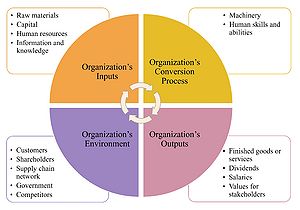
By going through the stages, the organizational values are created consecutively and how much value is created at each stage is determined by the how effective the organization is in managing each stage. Specifically, the conversion stage contributes to the amount of value created as it determines how the final product or service is created and fit into the value proposition for the customers. As the value proposition is delivered to the customers, its value is realized by the customers. And so, this value realization process induces changes in the environment. The organization receive capital resources, knowledge, and experience from their delivery by which these resources are circled back to the organizational input stage again to repeat the value creation process. The quality of products or services will be subjected to the effectiveness the organization is in process of value creation which affects how well the value proposition meet the customer's expectation. Moreover, the organization's abilities to respond to the environmental changes can also contribute to its success as it links back to the value realization process on the customers' side.
Given that the changes in the organizational environment is uncontrollable, and also affected by the organization itself, it is important for the organization to understands the elements of its value creation process and manage them accordingly. Organization theory is then developed to help managers in the organization understand, diagnose, and respond to emerging organizational needs and problems[4] and become more effective in the value creation process.
Organizational Environment
The organizational environment is the set of pressures and forces surrounding an organization that have the potential to affect the way it operates and its ability to acquire scarce resources[3]. It can be distinguished into two levels: specific environment and general environment. Specific environment consists of forces from the organization's external stakeholders that directly affect an organization’s value creation process, namely customers, distributors, unions, competitors, suppliers, and government. These stakeholders are involved in how organizational activities are carried out and how efficient and effective the processes are in doing so. A stakeholder can contribute positively to the value creation process, as well as obstruct. For example, suppliers are likely to work coherently with an organization as they both desire similar inducement, for instance, profits from more sales. On the contrary, government, for example, can interfere the way the business is conducted because they have the objective of regulating and controlling the society. Overall, an organization should engage and work closely with the stakeholders in the specific environment to ensure its ability to perform its value creation process.
General environment, on the other hand, consists of six intangible forces which rules over the specific environment and affect the ability of organizations to obtain resources[3]. The forces and their typical constituting elements are as discussed below:
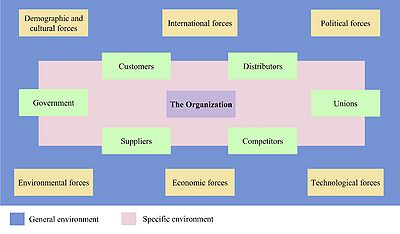
- Demographic and cultural forces: The forces include the characteristics of the society and its people, namely, age, lifestyle, values and norms, etc. They have the potential to create heavy influence to organization's customers as it is directly related to the perception and preference of the individuals.
- International force: The forces include globalization, transnational business regulations and agreements, etc. They play a part in shaping organization's business decisions which focus on improving operations, for instance, the decision whether to partner up with another organization overseas to combine knowledge and strengthen the value creation process.
- Political forces: The forces include laws and regulations, business standards, etc. They also influence organization's business decisions but more about appeasing particular business entities or avoiding introversy.
- Technological forces: The forces include discovery of new technical knowledge, the trend of the technology in the society, innovation of new equipment, etc. They can influence many aspects in the organization. It can influence the organization's conversion process design as it obtains the new technology which help improve process effectiveness and efficiency. Moreover, they can contribute to organizational development through technological learning which can be used to develop the organization's core competences.
- Economic forces: The forces include interest rate, unemployment rate, state of the economy, etc. They lay the basis of how the organization conduct the business, from designing its business strategy to designing its supply chain network.
- Environmental forces: The forces include environmentalist movement, abundancy and availability of raw materials, etc. They affect the organization's ability to obtain raw materials for its production. For organizations who provide services as value proposition, the forces can affect how the business strategy is design to accommodate sustainability and preservation of global resources.
The general forces are shared among the society that accommodates the organization and its business environment. Therefore, the general environment is dynamic in nature and beyond organization's control. Organizations are able to influence the forces to make them become in favor to their business through the value creation process, but it is only to a limited extent. This raises the issue of environmental uncertainty which can render the organization's ability to obtain resources.
Furthermore, given that specific forces are a part of a society which holds general forces, it implies that general forces are presiding over the specific forces. This relationship among the forces creates environmental complexity for the organization. The more interrelationships there are among the forces, the more effort is needed to manage them. A study suggests that uncertainty and the degree of the complexity and dynamics of the environment should not be considered as constant features in an organization[5]. Therefore, organizations need to assess these factors continuously and adapt to the changes to retain its effectiveness.
Organizational Effectiveness
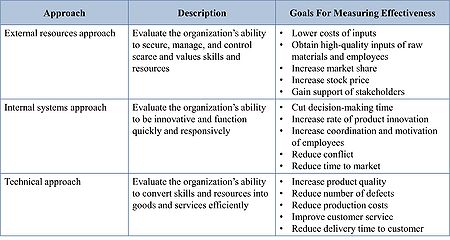
The survival of an organization depends on how effective the organization is in obtaining the scarce resources, from the environment of which it is in, and creating value. Thus, an effective organization is the one that can implement one or more of the following approaches[3]:
- External resource approach: to have control over its external environment and attract resources and customers
- Internal systems approach: to innovate new skills and capability to adapt to the changing environment to improve the way they function
- Technical approach: to develop new facilities through technological improvement which helps the organization deliver the value to the customers in a timely and cost-effective manner
The mentioned three approaches build the way for the organization to achieve its goals. In turn, the organizational goals are then used to assess the effectiveness of the organization as are set to reflect the organization's vision and mission.
Stakeholders
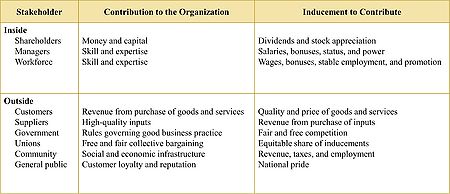
For an organization to be able to create value, it needs the resources and instructions in order to do so. Here, this is where stakeholders play an important role in driving the organization. Stakeholders are the people who have an interest, claim, or stake in an organization, in what it does, and in how well it performs[3]. They participate in the organization with the aim to gain inducements through making contributions to the organizational activities, based on their roles and abilities. There are many types of stakeholders, of which they contribute to the organization through different means with expectation for different inducements. Generally, the stakeholders of an organization can be distinguished into two main groups based on their involvement in the organizational value creation process: inside stakeholder and outside stakeholder. The inside stakeholders include shareholder, managers, and workforce who are directly involved in carrying out the value creation process. On the other hand, the outside stakeholders include all entities which are a part of the organizational environment and perceived to be affected by the organization's activity.
As each stakeholder is motivated to put in contributions by their own set of self-interests and personal goals. The organization must be monitored by the management body to ensure that all the stakeholders are working in an effective and efficient way while not putting their personal agendas over the common goal. For example, an organization that operates in a very dynamic environment should continuously search for ways to coordinate their employees to keep their ability to create value for the organization at a desired level. As shareholders evaluate an organization by the return they receive on their investment[3], the top management body should motivate the stakeholders with new proposition of inducements that fit the changing situations as well.
Organizational Design
Organizational Design is the process by which managers select and manage aspects of structure and culture so that an organization can control the activities necessary to achieve its goals[3]. The organizational design manifests explicitly in the form of the organizational chart which clearly states the roles of the employees and the delegation of authority. The principle behind designing the organizational chart is managing the differentiation which lays the foundation of establishing the division of labor.
Differentiation
Differentiation is the process by which an organization allocates people and resources to organizational tasks and establishes the task and authority relationships that allow the organization to achieve its goals[3]. Differentiation implementation results in the organizational chart with two dimensions: horizontal and vertical.
Vertical differentiation refers to the way an organization designs its hierarchy of authority and creates reporting relationships to link organizational roles and subunits[3]. When it comes to authority, it is about the individual's possession of power and control. Generally, the top level managers hold more authority as they direct and control the activities in the organization while lower level employees have less authority and their roles emphasize more on the execution of tasks and activities. Thus, the vertical differentiation reflects on the individual's cognitive limitations. So, the more member an organization has, the more probability that the vertical differentiation is high.
On the other hand, Horizontal differentiation refers to the way an organization groups organizational tasks into roles and roles into subunits (functions and divisions)[3]. The subunits are established based on the task which suits the expertise of their members. They can be established in two forms: functions and divisions. A function is a subunit composed of individuals with similar professional background and set of knowledge and skills who work on specialized tasks. As the subunits are only focused on their scope of work, it induces the learning process and improving the individual's knowledge and skills. On the other hand, a division is a subunit composed of individuals who have different backgrounds with different knowledge and skills set, working collectively to create a specific output. Thus, subunits in the form of divisions can be beneficial for performing complex tasks or innovative projects. Overall, horizontal differentiation can lead to improvements in the organizational capabilities as well as the control over organizational activities[3]. Moreover, when subunits are to be established, the work procedures, authority and responsibility of the individuals are explicitly specified. Thus, the number of different subunits that an organization possesses can reflect the organization’s complexity[3].
Overall, the vertical and horizontal differentiations are about constructing a structured relationship network among the organizational members. As much differentiations can help shape the organizational capabilities, they can also render out the organizational effectiveness in the value-creation process as well. This is because more work is needed to be done to ensure conformity in all the aspects given the differences among the members. Therefore, differentiations can be seen as one of the sources for organizational complexity[6], and thus can create difficulties for an organization to achieve its goals. However, a study suggested that differentiations can promote higher control over the organization[7]. When looking at the horizontal perspective, tasks of same specialty are groups and so they can be monitored by a specific control measure. As result, the study shows that the control measures for the activities are shown to be more completed as differentiation increases. Overall, it is important that an organization implement vertical and horizontal differentiations at the level that facilitate the work process towards the goals.
Centralization
Centralization refers to the organizational setup regarding the allocation of authority to the top managers to make decisions. This concept is related to the vertical differentiation which distinguish organizational members based on the level of authority that each member can have. Authority enables freedom for an individual to make a decision about certain things. Commonly, top managers in an organization hold the highest authority to make decisions for the organizational activities because they are perceived to be knowledgeable about the business and skillful in managing the organizational value creation process. A study claims that managerial self-efficacy influences managers' organizational attainments both directly and through its effects on their goal setting and analytic thinking[8] . Thus, to an extent, the performance of an organization can infer how well the organizational members make decisions, or in another word, exercising authority.
Moreover, as organization always comprises of more than one person and one activity, it is difficult that one person can oversee all the activities and make all the decisions there are in the value creation process. This raised the issue of how much centralization, or decentralization, an organization should implement in order to have the right people making the right decisions. Decentralization refers to the allocation of authority to the organizational members in the lower levels of the hierarchy. A decentralized organization is when the lower-level employees have the authority to make decisions and perform activities. The outcome of the decisions made by those who have authority can affect the organization effectiveness because all organizational activities utilize the organization's resources. This reflects to the sharing of responsibility and accountability among the organizational members. The more authority given to an individual, the more accountability that the individual needs to hold.
Centralization and decentralization are on the opposite ends of the authority spectrum. A highly-centralized organizations will have most of the decisions made by the top managers. They can gain the advantage of top managers being able to control of most of the aspects in the organization. However, if there are too many decisions to be made, one manager may only be able to comprehend a partial amount of them effectively given his cognitive limit. Thus, the cognitive limits of those who hold the authority will determine how comprehensive the organization is in making strategic decisions[9], affecting the organizational effectiveness. On the contrary, a highly-decentralized organization gains the advantage of high flexibility and responsiveness. This is because lower-level managers can make decisions at the point of where the decision problem is created. A study also suggested that a decentralized structure accommodates the organizational members' cognitive limitations[9]. Therefore, all of the decisions can be made more efficiently in a more decentralized organization because they are divided among the individuals and so each individual can utilize his cognitive ability on a more focus scope. However, decentralization can lead to a more difficult coordination among the organization as more individuals are making decisions on their own behalf.
Organizational context in project management
In the light of project management aspect, the organizational aspect is relevant in terms of the people facilitating the project. Given that projects are usually performed by a group of people, the natural results of individuals from different functional backgrounds working together are professional tension and personality friction [10]. This raise the issue of politics in project management which is influenced by how the people involved in the project is related to one another and also the work. Regardless of the tools and methodologies used in a project, politics and project management are different processes which are inextricably linked as the project success can be affected by how well the politics is managed[10]. Therefore, this shows the importance of the concept of organization theory and design. The relevance of the projects and the organization which involves with it can be articulated as follows:
Projects and organizational development
Organizations can exercise their business strategies through projects. Projects provide deliverables which can be modeled to contribute to the organizational strategy. Therefore, the potential outputs and outcomes of the projects should be considered when identifying opportunities and threats[11]. For example, an innovative company launches a research project about discovering emerging product trends in the market which will help them secure early introduction of new products that the market wants. This indicates that the organization gain new knowledge about new business opportunities which enables it to improve its value creation process.
Moreover, projects can also identify organizational threats as well. For example, if the research project suggests that the market wants a new product with a specific application, the company may expect a threat of new entrants in the market who are more specialized in that particular field. When threats are foreseen, it can help an organization plan their activities to manage the risks which would be induced by the identified threats.
Therefore, it is inductively suggesting that projects create learning process for the organization[12] through problem solving. Furthermore, as new knowledge is learnt and codified, it can be applied to future projects, leading to new innovations and development of organizational capabilities.
Additionally, a study in 1999 discusses that innovative projects, such as technology developments, are likely to have high uncertainty[13]. Thus, it findings claims that best management style for innovative organizations is based on expectations which include continuous reviews and evaluations, learning, and modification of plans. This management style is centered around organizational learning, leading to organizational changes and development. Moreover, increasing the effectiveness of the research efforts can also have a major impact on the organization well-being and survival as well.
Projects and programs as organization value creation process

A study in 2008 discusses the relation of organization theory to project and program managements through the value creation process. It states that the primary concern in the current business industry is increasingly the challenge of creating value and benefits for stakeholders and thus raises a need for a framework which help organizations improve their value creation process. The study proposes the implementation of Normann's framework into the traditional value creation process. The framework essentially includes the value aspect into the well-known triple constraint model in project management [14]. So when an organization runs a project, the framework urges the organization to consider how their stakeholders and customers create their own value from the output of the project. Thereby, the new model of value creation process enable the organization to model its activities and influence the value realization process by the stakeholders and customers [14].
Projects and organizational structure
Projects are related to the organizational structure in terms of how the project team make decisions about executing project tasks. Different team members have different knowledge and experience, self-interests, and moral. This can lead to internal conflicts among the members. Therefore, the project manager needs to design a authority structure in the project team. The structure design can be of any level of complexity depending on the characteristics of the project. Initially, the authority structure can include the member's area of authority and the amount of authority hold by a team member. By defining the area of authority, each member is allowed to make decision in a specific area of work, thereby, the person's cognitive ability is utilized on a smaller scope. The authority area of one member to another could be overlapped, but the scope of responsibility for each member should be clearly specified. If not, it can lead to some decisions having more than one person being responsible for it, creating conflict in making the decision. However, this problem can also be managed by negotiating or group discussion to develop common understanding towards the common goals. Another element of the authority structure is the amount of authority given to each project member which reflects the level of control of the project. This would help the project manager to ensure that the project team can deliver the work as expected.
Given that there are multidimensions to the people aspect of the organization as the individuals are more and uncontrollable, designing merely the authority structure is not sufficient. Many studies are done to propose a conceptual framework in designing the organization. The most widely acceptable organizational designs are functional organization, project organization, and matrix organization[1]. A functional organization will have high centralization by which the project managers have limited authority to make decisions. On the contrary, project organization will allow project managers to have full authority over the project. Since each of the two organization types will gain different advantages and disadvantages from the level of centralization, another organization design is developed to exploit the advantages of both extremes. A matrix organization is developed by combining functional departments with projects. This allows the project manager to make decisions about managing the project and ensuring that the deliverables are created as expected. Meanwhile, the authority is given to other project team members who are more specialized in the certain technical areas.
Projects and organizational resources
A pool of resources of an organization includes people of different skills, capital budget, machines and materials, etc. These resources are the main factors that an organization uses to drive its value creation process. When looking from the project management perspective, different sets of resources are needed for different projects due to the uniqueness characteristic of project. This raises the issue of allocating organization resources to projects in the most effective and optimized manner. However, the way the organizational structure is designed will influence how the resources are allocated to the projects and how they interact with each other, ultimately affecting the success level of a project. Therefore, different organizational structures are developed to facilitate different kinds of work or projects, from functional organization to project organization[1]. The appropriate organizational structure is the one that can accommodate the execution of the project based on the characteristics of the project.
A study in 1996 claims that the project management style is likely to be more flexible as the complexity of a project increases[15]. This is because a complex project expects high level of uncertainty which comes from the effort of ensuring conformity among the interrelated aspects of the project. The project managers then, need to be able to adapt quickly to the risks that may occur from these uncertainty. For this particular example, a flat organizational structure would be the best as it promotes flexibility due to faster decision-making as well as freedom of innovation.
Limitations
One main limitation of applying the organizational theory to any organization is that there is no universal solution for designing the organizational structure that ensure the project success. As projects are executed by people, the uniqueness of the individuals contributes to the complexity of the project. Although the organization structure is designed according to theory but there are still some elements which cannot be fully controlled, namely, the individual's moral, the innovation progress of the competitors, the availability of the resources in the environment, etc. Therefore, designing the organizational structure is a continuous process as the organization is affected by the changes in the environment which are unpredictable and uncontrollable.
Annotated Bibliography
Jones, G. R. (2013). Organizational theory, design, and change (pp. 31-33). Boston: Pearson.
The book discusses three main aspects in managing an organization: organization theory, organizational design, and organizational changes. Each of the three aspects comprises of many elements which altogether form an organization entity as well as the environment that the organization is in. As the organization theory, design, and change are conceptual and difficult to be measured, the book provides many business case studies to illustrate how the three aspects are manifested in the form of organizational performance. Implication ideas of the theories and concepts from the three aspects are also provided throughout the book.
Pinto, J. K. (2000). Understanding the role of politics in successful project management. International Journal of Project Management, 18(2), 85-91.
The paper discusses how organizational politics play a part in managing a project. It examines the three modes of power: authority, status, and influence. These factors are one of the key problems for project managers in managing projects in organizations. Thus, the paper provides some practical implications of project politics which enable project managers to oversee the behavioral side of the project. It suggests that successful project managers are aware that politics, used judiciously, can have an extraordinarily positive impact on the implementation of their projects.
Winter, M., & Szczepanek, T. (2008). Projects and programmes as value creation processes: A new perspective and some practical implications. International Journal of Project Management, 26(1), 95-103.
The paper presents a collective finding about the need of the industry for a more strategic approach to project management which focus more on delivering value and benefits to organizations. The paper refers to Richard Normann’s work about the idea of including value as another core aspect to the triple constraint model. Overall, a new conceptual framework is proposed to implement project and program as value creation process.
References
- ↑ 1.0 1.1 1.2 Geraldi, J., Thuesen, C., Oehmen, J., & Stingl, V. (2017). Doing Projects. A Nordic Flavour to Managing Projects. Danish Standards Foundation, 57-66.
- ↑ Gido, J., & Clements, J. (2014). Successful project management. Cengage Learning.
- ↑ 3.00 3.01 3.02 3.03 3.04 3.05 3.06 3.07 3.08 3.09 3.10 3.11 3.12 3.13 3.14 3.15 3.16 Jones, G. R. (2013). Organizational theory, design, and change. Boston: Pearson.
- ↑ Daft, R. L., Murphy, J., & Willmott, H. (2010). Organization theory and design (Vol. 10). Mason, OH: South-Western Cengage Learning.
- ↑ Duncan, R. B. (1972). Characteristics of organizational environments and perceived environmental uncertainty. Administrative science quarterly, 313-327.
- ↑ Hall, Richard H. (1972). Organizations: Structure and Process. Englewood Cliffs, N.J.: John Wiley and Sons.
- ↑ Ouchi, W. G. (1977). The relationship between organizational structure and organizational control. Administrative science quarterly, 95-113.
- ↑ Wood, R., & Bandura, A. (1989). Social cognitive theory of organizational management. Academy of management Review, 14(3), 361-384.
- ↑ 9.0 9.1 Fredrickson, J. W. (1986). The strategic decision process and organizational structure. Academy of management review, 11(2), 280-297.
- ↑ 10.0 10.1 Pinto, J. K. (2000). Understanding the role of politics in successful project management. International Journal of Project Management, 18(2), 85-91.
- ↑ Dansk Standard. (2021). DS/ISO 21502:2020. Göteborg Plads 1, DK2150 Nordhavn: Dansk Standards Associations.
- ↑ Winch, G. (1998). Zephyrs of creative destruction: understanding the management of innovation in construction. Building research & information, 26(5), 268-279.
- ↑ Sheasley, W. D. (1999). Leading the technology development process. Research-Technology Management, 42(3), 49-55.
- ↑ 14.0 14.1 14.2 Winter, M., & Szczepanek, T. (2008). Projects and programmes as value creation processes: A new perspective and some practical implications. International Journal of Project Management, 26(1), 95-103.
- ↑ Shenhar, A. J., & Dvir, D. (1996). Toward a typological theory of project management. Research policy, 25(4), 607-632.
